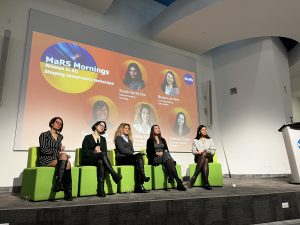Meighan Atkinson is the Communications Coordinator at CCRM. Meighan recently completed her Honours Bachelor of Arts degree at the University of Toronto, majoring in Professional Writing & Communications. Through her studies and contributions to The Medium as Staff Writer, Meighan discovered an interest in science communications.
Rarely do you read a news story about artificial intelligence (AI) with an optimistic tone. For the general public, AI continues to be a boogeyman, threatening to claim jobs or impersonate a loved one to extract money from you. More recently, the spread of deepfake video and photo content on social media —digitally edited to realistically imitate someone’s likeness, without their consent or participation—brought AI’s ability to propagate disinformation to the forefront.
In the cell and gene therapy field, as with the broader science, technology, engineering and mathematics (STEM) field, AI is often viewed in a different context. I recently attended a panel discussion in Toronto hosted by MaRS called “Women in AI: Shaping tomorrow’s techscape,” featuring speakers who have built careers in the AI space. The four female panelists highlighted the realities of AI: its cross-disciplinary benefits, its lifesaving capabilities in health care, and even its limitations—because, no, AI cannot do everything.
The panel reminded me of an episode of CCRM’s Commercializing Living Therapies podcast, called “From code to cure: Exploring the synergies of artificial intelligence and regenerative medicine.” The episode features two female guests utilizing AI in their respective biotechnology careers: Dr. Mamatha Bhat, Hepatologist & Co-Lead of Transplant AI initiative with the Toronto General Hospital Research Institute, and Dr. Julie Audet, Professor of Biomedical Engineering at the University of Toronto.
Combining what I learned from the podcast and the panel, here are my four takeaways.
1) AI isn’t taking jobs, but it’s changing them.
Dr. Mamatha Bhat points out that AI is not the first major disruptor in the field of biotechnology and that, historically, advancements require adjustment and adaptability. She suggests that it’s unlikely that the absolute number of jobs in the cell and gene therapy space will change dramatically, but the responsibilities of these jobs and the skill sets required to effectively incorporate emerging AI tools will certainly change.
Panelist Patricia Thaine, Co-Founder and CEO, Private AI, provides context for those of us in the communications, media and marketing fields: the core research, discovery and creation of today’s AI tools were completed years ago, but the work to understand their deployability in a business context is still to be done. Thaine suggests that those outside of tech disciplines may be at an advantage to identify problems and opportunities in AI that those in the field cannot see, and find success in the job market by offering solutions.
2) AI has the potential to solve biomanufacturing difficulties along the commercialization pipeline.
Dr. Julie Audet is optimistic about AI’s ability to solve persistent setbacks in the discovery and manufacturing of cell and gene therapies, pushing them through the pipeline into commercialization. In Dr. Audet’s work to optimize stem cell processes, her team uses AI tools to identify data stored in images and graphs, reducing time and resource burdens. With an endless bounty of information instantly available, AI quickens the discovery process by designing experiments and simultaneously controlling for cost.
In biomanufacturing, Dr. Audet believes that AI will be used to effectively scale up manufacturing processes by easily identifying cell lines’ optimal culture conditions, increasing therapies’ viability. AI can also control for a therapy’s infringement on existing patents, which will be integral for commercial applications.
3) AI will personalize patient care and treatment, leading to better health outcomes.
Panelist Melanie de Wit, Chief Legal Officer, Unity Health Toronto, identified CHARTWatch Surgical as an example of an AI tool that creates better health outcomes for patients by monitoring patterns in vital signs before they’re humanly detectable and predicting necessary interventions, reducing patient mortality by 25 per cent.
Dr. Bhat echoes the value of AI in personalizing patient care and treatment regimens: in clinical practice, AI tools not only aid in diagnosis, but can identify patient risk factors. Citing testing a compound on patient-derived cell lines as an example, Dr. Bhat suggests that AI can identify the best-performing compound based on a patient’s condition using protein confirmation tools and then design the compound accordingly.
4) As AI’s applications ramp up, more harmony between stakeholders is necessary.
Panelist Mèlika Carroll, Head of Global Government Affairs and Public Policy at Cohere, explains that as AI’s adoption continues to expand rapidly, so too does the pool of stakeholders. Speaking from her experience as a “bridge” between government regulators and AI tool developers, Carroll hopes that the future of AI will bring more transparency and trust between various stakeholders—including the public, as perceptions of AI continue to skew negatively. Similarly, Dr. Audet encourages patients to feel optimistic about AI and its role in their care, restating that although the technology is new to the general public, it has been in development for over a decade.
If you have an appetite for more AI, listen to “From code to cure: Exploring the synergies of artificial intelligence and regenerative medicine” here, or wherever you stream podcasts.
AI’s unprecedented capabilities will require adjustment and adaptability from all parties—from the cell and gene therapy developers employing AI tools, to government regulators, to the patients that will benefit from them—but the future is bright. As AI becomes more readily and reliably deployable, its applications in the development, manufacturing and commercialization of therapies become apparent.
Guest
Latest posts by Guest (see all)
- Regenerative immunotherapy: Hope for chronic autoimmune diseases - September 16, 2025
- Canada’s regenerative revolution: Why AI is the catalyst - September 4, 2025
- Summer by Design: A launchpad for future entrepreneurs and industry scientists - August 14, 2025







Comments